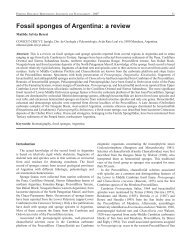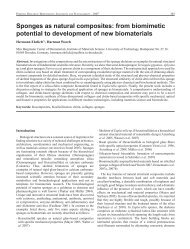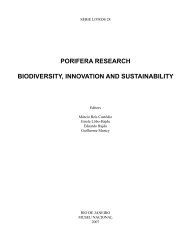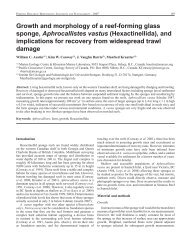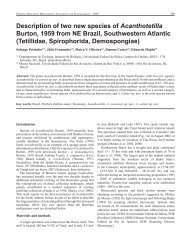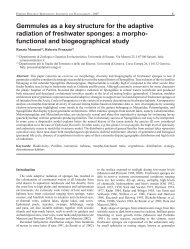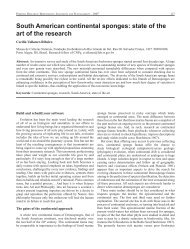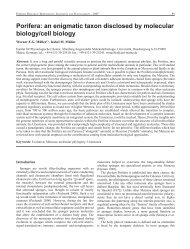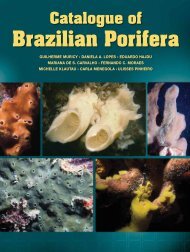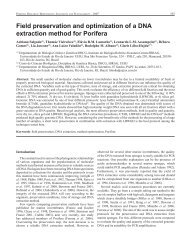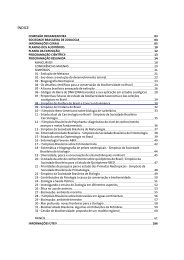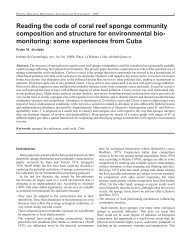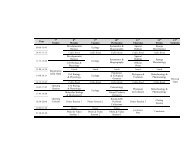Associations and interactions between gorgonians ... - Porifera Brasil
Associations and interactions between gorgonians ... - Porifera Brasil
Associations and interactions between gorgonians ... - Porifera Brasil
Create successful ePaper yourself
Turn your PDF publications into a flip-book with our unique Google optimized e-Paper software.
446species are equivalent to their relative abundances in thestudy site. This result indicates that the number of coloniesof the gorgonian species associated with sponges are mostlydetermined by the abundances of the gorgonian species.<strong>Associations</strong> <strong>between</strong> sponges <strong>and</strong> gorgonian species can bedescribed as r<strong>and</strong>om in this respect. A notable exception tothis overall r<strong>and</strong>om pattern was Briareum, which was foundhighly associated with sponges relative to its low abundance.Most <strong>interactions</strong> with sponges had negative effects on<strong>gorgonians</strong> as observed in the overgrowth (smothering) ofvarious gorgonian species by sponges such as Desmapsammaanchorata, Dysidea janiae <strong>and</strong> Iotrochota birotulata.Smothering could be ‘direct’ in the sense that the spongeadhered directly to the tissue/skeleton of the overgrownorganism (i.e., direct smothering, Fig. 2) or ‘indirect’ wherelethal or non lethal effects occurred without the adherenceof the sponge tissue (i.e., indirect smothering). These <strong>and</strong>other <strong>interactions</strong> are given in Table 3. These <strong>interactions</strong>were often species-specific. For instance, Desmapsammaanchorata usually outcompeted Pseudopterogorgia spp.by direct overgrowth but tissue discoloration of Gorgoniaventalina adjacent to the growing edge of Desmapsamma(Fig. 3) indicated the presence of allelochemicals.A notable exception to the negative <strong>interactions</strong>with <strong>gorgonians</strong> was observed <strong>between</strong> Briareum <strong>and</strong>Desmapsamma anchorata, Amphimedon compressa, <strong>and</strong>Mycale carmigropila. In these cases, Briareum <strong>and</strong> spongecolonies were intertwined <strong>and</strong> no indications of negative<strong>interactions</strong> were observed.DiscussionWe stress that the results of this study are preliminary inthe sense that future observations will increase the numberof sponges <strong>and</strong> associated species as well as species-specific<strong>interactions</strong>. Nevertheless, some general inferences can bemade about Caribbean sponges <strong>and</strong> the biodiversity of coralreefs. As in the case of tropical rainforests where the treecanopy accounts for much of the biodiversity, the gorgonian‘canopy’ serves as a habitat for many sponge species. Ourresults thus indicate that the high biodiversity of sponges ispartially attributable to their ability to circumvent substratespace limitation in coral reefs (Connell 1978) by growingepibiotically on other sessile organisms (Rützler 1970). Inturn, sponges harbor numerous invertebrate species (Neves<strong>and</strong> Omena 2003, Ribeiro et al. 2003).The associations <strong>and</strong> <strong>interactions</strong> of sponges with otherspecies also affect the biodiversity of sponges. Our resultssuggest that, with the exception of Briareum, the relativeabundance of gorgonian taxa largely determines theirassociations with sponges. This pattern represents a r<strong>and</strong>omassociation in the sense that the probability of a gorgoniancolony being associated with sponges is equal amongindividuals of all gorgonian species. In contrast to patternsof associations, <strong>interactions</strong> <strong>between</strong> sponges <strong>and</strong> <strong>gorgonians</strong>are often species-specific. Depending upon the speciesinvolved negative <strong>interactions</strong> may involve direct or indirectsmothering or allelochemicals. Also, in addition to negative<strong>interactions</strong>, the intertwined growth morphology observed<strong>between</strong> Briareum <strong>and</strong> various sponges may be indicativeFig. 2: Adherence of Dysidea janiae to Pseudoplexaura spp. Directsmothering of the tissue of Pseudoplexaura spp. caused by theovergrowing Dysidea janiae.Table 3: Sponges associated with <strong>gorgonians</strong> <strong>and</strong> their modes ofinteraction.SpeciesAmphimedon compressaAmphimedon erinaCallyspongia vaginalisDesmapsamma anchorataDysidea janiaeIotrochota birotulataIrcinia strobilinaMonanchora arbusculaMonanchora unguiferaMycale laevisMycale microsigmatosaNiphates erectaScopalina ruetzleriXestospongia caycedoiInteractionsovergrowth, smothering <strong>and</strong>intertwined growthsmotheringsmotheringovergrowth, smothering <strong>and</strong>intertwined growthovergrowth, smotheringovergrowth, smotheringovergrowth, smotheringovergrowthsmotheringsmotheringintertwined growthovergrowth, smotheringsmotheringsmothering



